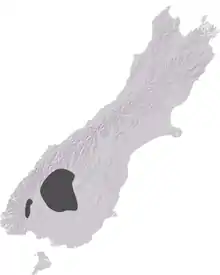| Alpinacris tumidicauda | |
|---|---|
 | |
| Female | |
| Scientific classification | |
| Domain: | Eukaryota |
| Kingdom: | Animalia |
| Phylum: | Arthropoda |
| Class: | Insecta |
| Order: | Orthoptera |
| Suborder: | Caelifera |
| Family: | Acrididae |
| Genus: | Alpinacris |
| Species: | A. tumidicauda |
| Binomial name | |
| Alpinacris tumidicauda Bigelow, 1967 [1] | |
 | |
| The distribution of A. tumidicauda in New Zealand | |
Alpinacris tumidicauda is a species of grasshopper only known from Otago and Southland, New Zealand. The genus Alpinacris is endemic to the South Island of New Zealand. A. tumidicauda was described in 1967 by Robert Sidney Bigelow,[1] with a type locality of Obelisk (Māori: Kopuwai) in the Old Man Range (45°19′22″S 169°12′27″E / 45.3228°S 169.2074°E). A male holotype and paratype are deposited in the Canterbury Museum, Christchurch. Like all of New Zealand sub-alpine and alpine grasshoppers, A. tumidicauda has a 2- or 3-year life cycle. The eggs must "overwinter" before they will hatch. Hoppers are found throughout the year, and adult grasshoppers can be found throughout the New Zealand summer between December and April. The adult A. tumidicauda do not overwinter.
Distribution and habitat

Mount Burn 45°44′46″S 167°24′29″E / 45.746195°S 167.407987°E
Alpinacris tumidicauda is known only from the Otago and Southland regions of New Zealand.[2] It can be found as far south as Cleughearn Peak (45°49′43″S 167°24′11″E / 45.8287°S 167.4030°E) and as far north as Mount Aurum (44°46′10″S 168°37′21″E / 44.7695°S 168.6225°E). Alpinacris tumidicauda prefers alpine tussock grasslands between 1,300 and 1,700 metres (4,300 and 5,600 ft); it can, however, be found as low as 700 metres (2,300 ft) near the Nevis River (45°08′49″S 169°00′00″E / 45.147°S 169.000°E). It is one of three known species of alpine grasshoppers that are found in Fiordland, the other two being Sigaus homerensis and Sigaus takahe.[3]
Alpinacris tumidicauda has a "sister species", Alpinacris crassicauda. There would have originally been only one species of Alpinacris in the South Island; however, the Alpine Fault has separated this species over time, so at the present there are two species—A. tumidicauda in southeast of the South Island and A. crassicauda in the northwest of the island.[4][5]
Species description
Alpinacris tumidicauda is micropterous (small-winged), with wings measuring between 2 and 4 millimetres (0.079 and 0.157 in), making this species flightless like most New Zealand grasshoppers. Male body length is 12–14 millimetres (0.47–0.55 in); female body length is 21–24 millimetres (0.83–0.94 in).
Type information
- Bigelow, R. S. (1967). The Grasshoppers of New Zealand, Their Taxonomy and Distribution. Christchurch: University of Canterbury
- Type locality: Obelisk, Old Man Range, Otago, 1,372 metres (4,501 ft)
- Type specimen: Male; 3 December 1963; R. S. Bigelow. Holotype and paratype are deposited in the Canterbury Museum, Christchurch.
Polymorphism
Four colour morphs are known for adult A. tumidicauda: green, olive, dark olive and yellow-brown. The most common colour morph is green, followed by the yellow-brown colour morph.
 Green colour morph
Green colour morph Olive colour morph
Olive colour morph Dark olive colour morph
Dark olive colour morph Yellow-brown colour morph
Yellow-brown colour morph
References
- 1 2 R. S. Bigelow (1967). The Grasshoppers of New Zealand, their Taxonomy and Distribution. Christchurch: University of Canterbury.
- ↑ Morris SJ. 2002. Distribution and Taxonomic status of New Zealand endangered grasshoppers (Orthoptera: Acrididae). Department of Conservation, Wellington.
- ↑ Morris, S.J. 2003: Two new species of Sigaus from Fiordland, New Zealand (Orthoptera: Acrididae). New Zealand entomologist, 26: 65–74. PDF Archived 2011-07-21 at the Wayback Machine
- ↑ Trewick SA, Wallis GP. 2001: Bridging the “beech-gap”: New Zealand invertebrate phylogeography implicates Pleistocene glaciation and pliocene isolation. Evolution 55, No. 11: 2170–2180.
- ↑ Heads, M. 1998. Biogeographic disjunction along the Alpine Fault, New Zealand. Biol. J. Linn. Soc. 63:161–176.